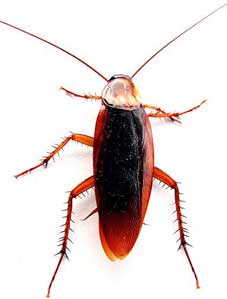It is common understanding that in the aftermath of a nuclear war, cockroaches will inherit the world. But is it actually true? Cockroaches are known for their durability and adaptability – it’s what makes them such an annoying pest. Anyone who has had a cockroach infestation in their home could reasonably believe that a cockroach would survive a nuclear Holocaust.
The assumption could perhaps be traced back to a story called “The Figure” written by Edward Grendon, which appeared in a literary journal called Astounding Science Fiction in the summer of 1947. The story follows a fictional team of scientists who discover reports of roaches terrorizing the streets of Hiroshima and Nagasaki after the explosion of the atomic bomb. “They came out suddenly one night by the millions,” Grendon wrote. “It’s been estimated that they killed and ate several hundred people before they were brought under control.” Grendon’s story was a work of his imagination. With all the variables that come with explosions, no one really knows what would happen, but a comparison of the two forces could produce a good guess.
Contender 1: The Cockroach
Of the 4,500 species of cockroaches, only 30 live where humans do, and they include the the German cockroach, Oriental cockroach, the American cockroach, and the Asian cockroach. They can adapt to almost any habitat but prefer warm places, like buildings or, better yet, tropical forests.
Cockroaches have spines on their legs that help them navigate the toughest terrain. Cockroaches are highly social creatures and prefer to live in colonies that are egalitarian and share resources.
Contender 2: The Nuclear Bomb
Nuclear bombs use the processes of nuclear fission and fusion to create a huge explosion and release radiation that lingers in atmosphere. Their blast winds can travel at almost the speed of sound and moderately damage most buildings if ignited in an urban area. Humans near the center of the explosion would die in seconds, and radiation poisoning would kill or severely injure nearby survivors.
Round One: The Explosion
Interestingly, the flash associated with nuclear bombs is due to thermal energy that produces ultraviolet and infrared light. Cockroaches love the darkness and hide from light, which is why they act so franticly when running through a bright living room. Unfortunately, in the event of a nuclear bomb exploding, those cockroaches walking outside in the open would not have time to run away from the bomb’s light and would suffer severe vision damage. However, the flash associated with a nuclear explosion would not affect roaches hiding underground or within sturdy buildings. It should be noted that the Asian cockroach differs from its brethren and is actually attracted to light, so they might actually run toward a nuclear explosion.
The radiation released by the bomb would likely start fires, but most of those fires would quickly be extinguished by the strong blast wind. In an urban areas, the explosion could set of a chain reaction and cause furnaces and gas tanks to explode, creating a massive firestorm. The impact of the bomb could also cause a minor earthquake. Roaches too close to ground zero wouldn’t make it.
Round Two: The Fallout
After the fire, winds and earthquakes have ceased, radioactive residue, called nuclear fallout, would rain down, contaminating all it touches. Contamination can cause cellular mutations that turn into cancer, infertility and genetic mutations. Some of these effects are immediate and some emerge years later.
Cockroaches biologically have a much higher tolerance to radiation than humans. Radiation damages cells that are in the process of dividing. Human cells constantly divide, leaving them especially vulnerable. On the other hand, cockroaches’ cells divide once a weak, at which point they molt their old skin, leaving their contaminated shell behind.
Round 3: The Aftermath
The cockroach may survive the blast and have a lower risk of contamination, but will it have anything to feed on? Most things will be contaminated by nuclear fallout for a little while, but that’s just fine because cockroaches can survive for a month without food. They are not picky eaters at all; they can survive off of postage stamp glue if they have to.
Conclusion
Roaches would fair better than humans in a nuclear disaster. Those too close to the blast would incinerate, but the ones who are out of direct exposure to bomb would survive, though many would eventually die from radiation poisoning. They certainly will not feed off of the radiation and grow to be the size of dinosaurs. A real science fiction horror story could detail the reign of the confused flour beetle, which can withstand radiation levels 100 times that of what it takes to kill a human being. Or maybe the mite rotifer, who can survive in outer space, will be the next horror movie star. If you enjoyed this article, check out my latest guides on resolving flea problems in your home. Thanks for reading! 🙂
Hello! My name is Natasha, and I have been helping people with their insect problems since 2012. I have published a book, worked with many pest control companies, and helped thousands with various infestations on a one-to-one basis. My goal for this blog is to create evidence-based guides that are easy to understand, provide sufficient depth and can be trusted to be very accurate. Please remember that my guides are for informational purposes only, and that you agree to the terms of use when reading content on this website. If you leave a comment, I typically respond within 48 hours.





Speak Your Mind